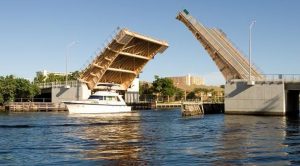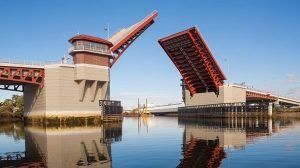Hydraulic Bridge – its 3 Types, Working & Advantages
The hydraulic bridge incorporates an integrated hydraulic system into the bridge to carry more weight and is a new concept in bridge design.
For arch-based bridges in which the main forces are directed in a horizontal sideways direction, this system is most suitable and the hydraulic system is integrated into the prominent load-bearing members of the bridge and can be minimally controlled by computers.

For non-electronic autonomic self-adjustment, the system has the possibility which entails low maintenance cost and reduced safety risk, and the hydraulic bridge has two main functions such as when it raises the boats to pass beneath it and cross it.
The movement of the bridge is based on simple pulleys and these pulleys allow raising the bridge 90 degrees and then rejoining the bridge. The hydraulic bridge is a type of movable bridge to allow maritime traffic through a body of water that can be raised with the help of mechanical installation.
For the need of the merchantman, a hydraulic bridge was created as they needed a bridge with a double function such as to facilitate the passage of boats down a river and for a ship to pass under it and permit the move terrestrially without the bridge being too high.
Working on Hydraulic Bridge:
The principle behind hydraulic bridge working is Pascal’s law and for operations, this bridge uses petroleum-based hydraulic fluids. For powering the bridge with hydraulics, hydraulic motors and hydraulic cylinders are two important components used and the amount of gearing required is dependent on the type of hydraulic motor for a bridge operation.
Depending on the construction, the hydraulic cylinders can be divided into tie rods and welded and for providing longevity for the bridge, the welded hydraulic cylinder is suitable.
To carry varying loads and hold the bridge firmly in any position, counterbalance valves used in the structure will help in this and by the proportional valve used, smooth and accurate acceleration and deceleration are provided.
Types of Hydraulic Bridge:
There are three main types of the hydraulic bridge as given below;
- Bascule Bridge
- Vertical Lifting Bridge
- Swing Bridge
Bascule Bridge:
This type of bridge is fixed and supported on an axis that is perpendicular to the longitudinal axis of the bridge and the horizontal axis is located at the centre of gravity on which the bridge is hinged. So, between the weights of the bridge on either side, a balance is created.

Bascule bridges are classified into two major types such as Single Leaf Bascule Bridge and Double Leaf Bascule Bridge and depending on the situation, there are also other types like triple and quadruple bascule bridges.
As ‘leaf’ is the part of the bridge which opens the water traffic and pivots concerning the horizontal axis.
There are the following advantages of bascule bridges such as;
- It is structurally sound.
- It is reliable.
- Construction and operations are economical in this bridge.
Vertical Lifting Bridge:
A vertical lifting bridge is the most common type which is constructed and consists of a span of a common type of truss and at the end of the span, supported by towers. Generally, the weight of this span is counterbalanced and by making the span move in the vertical direction, the waterway is opened.

It is called a span drive vertical lift bridge if the machinery which is responsible for the up and down movement of the span is fixed on the span itself and it is called a towering drive vertical lift bridge if that machinery is set on the towers.
These bridges can be used for locations where long spans are required and are substantially stable.
Swing Bridge:
Swing-bridge is fixed on the horizontal plane that turns around the vertical axis to give way for the water traffic and the bearing is installed on a pivotal pier which is a normal pier. The ends of the span of this bridge rest on the abutments when the water traffic is closed.

The end span should be free and is only supported by the pivotal pier when the water traffic has to be opened. So, to lift the end of the swing span machinery is used and the swing bridge moves horizontally around the vertical axis.
The swing bridge should be supported both horizontally and vertically to be able to carry the traffic and prevent overstressing. The span of the swing bridge can be either a plate girder or truss but more economical is a plate girder.
Advantages of Hydraulic Bridge:
There are the following advantages of a hydraulic bridge such as;
- Provides smooth and accurate acceleration and deceleration.
- It has safe and easy operations.
- It can carry varying loads.
- Behind hydraulic bridge working, Pascal’s law is the principle.
- The operator of a hydraulic system can easily start, stop speed up and slow down by using simple levers and push buttons.
- Positive locking in any condition is another advantage of this bridge.
